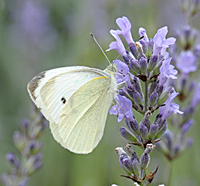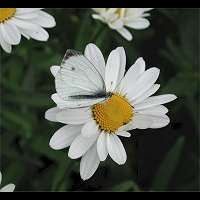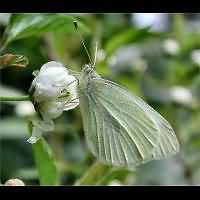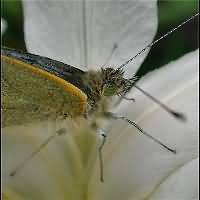[All pictures of garden wildlife on this page are thumbnails. Click on any thumbnail for a large format to be displayed.]
Small White (Pieris rapae)
Small White (Pieris rapae)
The Small White is distributed virtually all over the world and reached Australia in 1929, after having been imported in Northern America (first seen Canada in the 1860's, reaching Hawaii in 1898). The species is often referred to as Cabbage White, a name sometimes used for both species the Small White and the Large White. In Australia though only the Small White is meant, as it is the only Cabbage White down under. In Japan the species is called the European Cabbage White. In Northern America however this species is called the Imported Cabbageworm or the Cabbage Butterfly. The Small White is about the size of the Green-veined White, reaching a wingspan of some 45 to 50 mm. It looks like the Green-veined White a lot, but the veins on the backside of the wings are not emphasized by markings. The frontside is identical to that of the Green-veined White: both sexes have the tip of the wings darkened, the males carry one dark dot, the females two. The backside of the wing is quite variable: from a bleached yellowish white to a heavily spotted yellow. These spots however are never concentrated around the veins like in the Green-veined White.
Even though members of the 2nd and 3rd brood usually are a little darker than those of the first generation of the year, these differences are hard to notice and are not as apparent as in the Green-veined White. The Small White is considered to be a real pest in agriculture. Especially in cabbage, mustard, raddish and cress it can do a lot of damage. People have been trying to eliminate the species for centuries, but haven't been very succesful. In modern days poison is still used all over the world, but in protected environments particularly biological methods are used as well. Especially an European parasitc wasp (Apanteles sp.) seems to be quite useful. Other natural enemies include beetles, such as a few Ladybirds, Daddy Long Legs, such as Phalangium opilio, a Plant Bug, certain parasitic flies and a virus. Still, The Small White is very common everywhere and one of the most frequent visitors to gardens, whether in Melbourne, Amsterdam or San Francisco.
In the moderate zones of the world, the Small White will produce some 3 to 4 broods. In subtropical areas it will produce some 8 broods with no pauze whatsoever. When conditions are good, the butterfly will emerge from her pupae after just two weeks! The caterpillars are green, covered with short hairs and do look like the caterpillars of many of the other whites. It is the pupa overwintering, often found on gardenfences, walls etc. Perhaps this is the pupa seen most often by people. Just like some other whites, the Small White is adapted living in moderate climate zones. Thus it is rarely seen sunbathing. Taking pictures of an animal showing the upperside of the wings is a very difficult task. The beautiful blue eyes however are easy to photograph, as the animal is not shy towards people.
The Small White is distributed virtually all over the world and reached Australia in 1929, after having been imported in Northern America (first seen Canada in the 1860's, reaching Hawaii in 1898). The species is often referred to as Cabbage White, a name sometimes used for both species the Small White and the Large White. In Australia though only the Small White is meant, as it is the only Cabbage White down under. In Japan the species is called the European Cabbage White. In Northern America however this species is called the Imported Cabbageworm or the Cabbage Butterfly. The Small White is about the size of the Green-veined White, reaching a wingspan of some 45 to 50 mm. It looks like the Green-veined White a lot, but the veins on the backside of the wings are not emphasized by markings. The frontside is identical to that of the Green-veined White: both sexes have the tip of the wings darkened, the males carry one dark dot, the females two. The backside of the wing is quite variable: from a bleached yellowish white to a heavily spotted yellow. These spots however are never concentrated around the veins like in the Green-veined White.
Even though members of the 2nd and 3rd brood usually are a little darker than those of the first generation of the year, these differences are hard to notice and are not as apparent as in the Green-veined White. The Small White is considered to be a real pest in agriculture. Especially in cabbage, mustard, raddish and cress it can do a lot of damage. People have been trying to eliminate the species for centuries, but haven't been very succesful. In modern days poison is still used all over the world, but in protected environments particularly biological methods are used as well. Especially an European parasitc wasp (Apanteles sp.) seems to be quite useful. Other natural enemies include beetles, such as a few Ladybirds, Daddy Long Legs, such as Phalangium opilio, a Plant Bug, certain parasitic flies and a virus. Still, The Small White is very common everywhere and one of the most frequent visitors to gardens, whether in Melbourne, Amsterdam or San Francisco.
In the moderate zones of the world, the Small White will produce some 3 to 4 broods. In subtropical areas it will produce some 8 broods with no pauze whatsoever. When conditions are good, the butterfly will emerge from her pupae after just two weeks! The caterpillars are green, covered with short hairs and do look like the caterpillars of many of the other whites. It is the pupa overwintering, often found on gardenfences, walls etc. Perhaps this is the pupa seen most often by people. Just like some other whites, the Small White is adapted living in moderate climate zones. Thus it is rarely seen sunbathing. Taking pictures of an animal showing the upperside of the wings is a very difficult task. The beautiful blue eyes however are easy to photograph, as the animal is not shy towards people.

© Copyright 1998-2024 gardensafari.net (Hania Berdys)

 English / engels
English / engels  Dutch / nederlands
Dutch / nederlands







